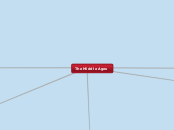The Middle Ages
Religion
Heaven and Hell
The idea of heaven
provided comfort to people
and the idea of hell created fear
withing the people
Roman Catholicism
Everyone in the west
believed in God and followed
Roman Catholicism.
God
Was used as an explanation
for everything. For example
accidents.
Church
Gothic Architecture
Church was the tallest building.
It dwarfed humans and made people
believe that god was the highest power.
Pope
Religious figure who ruled
the church and ran the clergy.
Had a lot of power and this power
and this power led to quarrels with
the king.
tax called a “tithe”
Villagers had to pay 1/10
of their crops as tax. Also your
2nd best animal was to be given
to the church after death.
Church services were held
in Latin and ordinary people
couldn't understand Latin.
Monks
best educated people in medieval society
and monasteries were important
centers of learning.
The Black Death
Blame
God, Jews, Lepers
Bubonic
A germ which lived
in the blood of rats
and in the guts of fleas
that traveled around
in their fur. Rats would
pass it on by biting
humans.
Victims would get a
fever and get large boils
Pneumonic
Caused by a
germ that travels
through the air.
attacked the lungs
causing victims to
cough up blood
Victims would
die within a
few days.
Consequences
Killed roughly 75
million people in
Europe.
Church lost power as
people lost faith in god.
Caused a lot of
panic among the
population.
Attempts to stop
the plague.
Leeching
Doctors
Doctors wore a robe
and carried flowers
to ward off the smell
of the dead. They would
also wear a beak like object
to avoid inhaling infected air.
Social Structure
The Divine Right of Kings
A monarch is subject to no earthly
authority, deriving the right to rule
directly from the will of God.
The Feudal System
A social, political and military
structure that laid out where
various people were according
to their rank in society.
In order from highest ranking;
Kings, Nobles, Knights, Peasants.
Also, men were always above women.
Historiography
Dictated by males,
often priests or monks.
The Great Chain of Being
A strict hierarchical structure
of all matter and life, thought
in medieval Christianity to
have been decreed by God.
Justice
No police forces.
Villages and towns
had to take care of law
and punishment by them
selves.
If you witnessed a crime
you had to shout so people
would help to catch the criminal
Tithings
men and women over
the age of 12 were
grouped into ten and
were responsible for
each other's behaviour
If a member of the
tithing broke the
law the others had to
take him or her to court
and pay their fines.
Watch
Group of people
patrolled the
streets at night
A constable was
chosen to coordinate
them.
Punishments
Criminals who
committed minor
crimes would be
taken to the lords
manor house.
The lord would decide
on the punishment,
which would usually
be a fine.
the punishment could
be harsher. The criminal
could be humiliated by
being tied up and whipped
publicly, put in stocks or a
pillory, etc.
Escaping punishment
hide in a church and claim
sanctuary.
You could also read a verse
from the bible
allow you to claim the benefit
of the clergy, which was a
different type of court system
that gave out less
severe punishments.
Harsh punishments
Murderers could be executed in
any number of ways and each
town or village would have their
own way of punishing these crimes.
Hanging, being buried alive, burned
to death, thrown off a bridge or cliff, being
drawn, quartered (being cut into pieces),
beheaded (typically nobles) were popular
punishments.
punishments were public which
served as a deterrent
to other criminals. They were also
entertaining.
Trials
serious criminal cases would
be dealt with by a royal court
who was a judge who travelled
around the country and visited
each village twice a year to hear
serious cases.
Trial by fire
involved holding a red-hot iron bar.
The hand is then bandaged and 3 days
later examined by the judge. If the wound
is healed then god must think the prisoner
is worth helping and so they are innocent.
Ordeal by water
involved the accused being tied up
and thrown into a lake or river. If
the prisoner floats, the water doesn’t
want him and he is impure, he is
guilty. If the prisoner sinks and
drowns then God must want him
in heaven and he is innocent.
Ordeal by combat
trial for the rich where the accuser
would fight the accused. You could
also get a champion to fight for you.
Art and Science
Gothic Architecture
used in churches
Monks
the best educated people
in medieval society. They
studied and copied ancient
manuscripts.
Medicine
First you would ask
around villagers for
a cure. You would go
to a doctor as a last resort
since it was expensive.
Theory of the 4 humors
the body was made up of 4
elements: phlegm, blood,
yellow bile, black bile.
Sickness meant that
1 of these was out of
balance, so the doctor
would try to figure out
what was out of balance
Sciences.
Not many discoveries
were made as god was
used as an explanation
for everything. Questioning
god was not an option.
Philosophy
Theology
New ideas were
shut down
Paintings
Doom Paintings
Paintings depicted
end of the world and
served as caution.
Interpretations of Christ.
